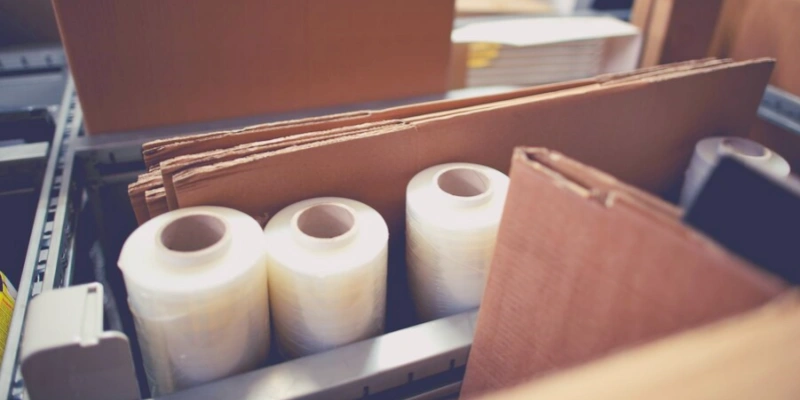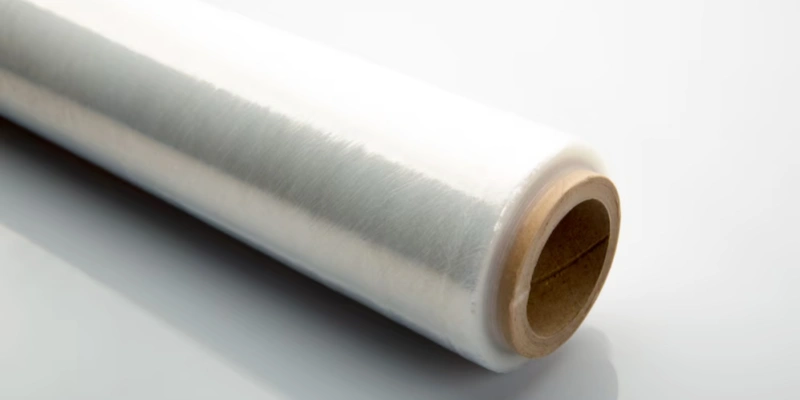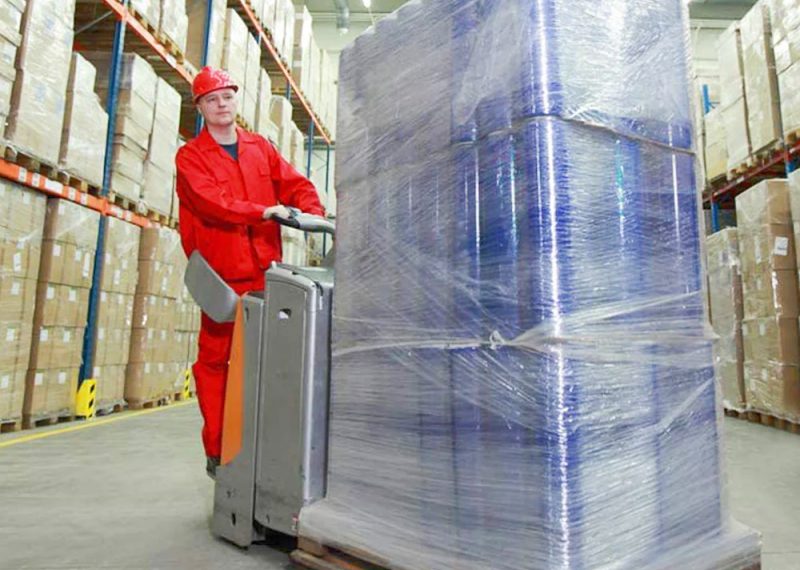
In an era where efficiency and sustainability collide, Large cling wrap have emerged as unsung heroes across industries and households. While standard plastic wrap dominates grocery shelves, savvy users are turning to bulk rolls – typically ranging from 1,000 to 2,000 feet – to slash packaging costs by up to 60%. This shift isn’t merely about quantity; it’s a strategic response to evolving needs.
Commercial kitchens now prioritize NSF-certified films that withstand -40°F freezer storage, while logistics teams demand 20-micron thick wraps to secure pallets during cross-country shipments. Simultaneously, households are discovering these industrial-grade solutions for unconventional uses – from weatherproofing moving boxes to creating temporary greenhouse covers for spring gardening.
Yet the buying landscape presents challenges. A 2023 PMMI report reveals 43% of first-time bulk buyers regret purchases due to mismatched specifications: a restaurant owner might waste $387 annually using overly thick film, while a DIY enthusiast struggles with dispensers designed for 18″ commercial rolls. Environmental concerns further complicate decisions, with only 1 in 7 municipal recycling programs accepting conventional polyethylene wraps.
Large rolls of cling wrap, also known as stretch film or plastic wrap, are oversized rolls of thin, flexible plastic material designed to securely cover, protect, and preserve items. Unlike standard household cling wrap sold in smaller rolls (typically 100–300 feet), large rolls range from 1,000 to 2,000 feet in length, making them ideal for high-frequency use in both commercial and household settings.
While traditional LDPE cling wrap is not biodegradable, large rolls can indirectly reduce environmental impact by:
To help users make informed purchasing decisions, this section breaks down the technical specifications and performance benchmarks that define high-quality large cling wrap rolls. These metrics are critical for both commercial buyers (e.g., warehouses, restaurants) and households seeking durability and cost-efficiency.
| Parameter | Details |
|---|---|
| Material | LDPE (Low-Density Polyethylene) – Lightweight, flexible, and puncture-resistant. Some variants use LLDPE (Linear LDPE) for added stretchability. |
| Thickness | 10–20 microns (vs. 8–12 microns for standard household wraps). Thicker films resist tears during pallet wrapping or heavy-duty use. |
| Width | 12–18 inches – Wider than retail wraps (typically 12 inches) to cover large surfaces efficiently. |
| Length | 1,000–2,000 feet – Bulk sizing minimizes roll changes and reduces long-term costs. |
| Color/Clarity | Clear (standard) or tinted (UV-resistant options for outdoor storage). |
| Core Size | 3-inch diameter (standard) – Compatible with manual and electric dispensers. |
| Weight per Roll | 5–10 lbs (depends on length and thickness) – Light enough for manual handling. |
| Rolls per Case | 4–12 rolls – Bulk packaging for commercial users. |
| Metric | Large Rolls (1,000–2,000ft) | Standard Rolls (100–300ft) |
|---|---|---|
| Cost per Foot | 0.005–0.01 | 0.02–0.05 |
| Durability | 10–20 microns thickness | 8–12 microns thickness |
| Use Case | Commercial kitchens, logistics, bulk storage | Household food storage, small projects |
| Eco-Footprint | Less packaging waste per foot | Higher plastic waste from frequent replacements |

Choosing between 1,000ft and 2,000ft large cling wrap rolls depends on your usage frequency, storage capacity, budget, and specific needs. Here’s a detailed comparison to help you decide:
| Metric | 1,000ft Roll | 2,000ft Roll |
|---|---|---|
| Upfront Cost | 15–30 | 25–50 |
| Cost per Foot | 0.015–0.03 | 0.0125–0.025 |
| Savings Potential | 10–20% cheaper than retail rolls | 25–40% cheaper than retail rolls |
Key Insight:
| Factor | 1,000ft Roll | 2,000ft Roll |
|---|---|---|
| Weight | 5–8 lbs (easy to lift and maneuver) | 10–15 lbs (may require two-handed use) |
| Space Required | 12" x 12" x 6" (compact storage) | 18" x 12" x 8" (needs dedicated shelf) |
| Dispenser Compatibility | Fits most manual/tabletop dispensers | May require heavy-duty dispensers |
Pro Tips:
Choose 1,000ft If You…
Choose 2,000ft If You…
Selecting the ideal cling wrap size for commercial use requires balancing operational efficiency, cost-effectiveness, and industry-specific demands. Below is a structured approach to help businesses make informed decisions, tailored to sectors like food service, logistics, retail, and manufacturing.
Key Questions:
Pro Tip: Track usage over a month to identify patterns and avoid stockouts.
| Industry | Typical Requirements | Recommended Size |
|---|---|---|
| Food Service | FDA-approved, anti-fog, daily tray wraps | 1,000–2,000ft food-grade rolls |
| Logistics/Warehousing | High tear strength, UV resistance | 2,000ft reinforced pallet wrap |
| Retail Packaging | Tamper-evident seals, clarity for branding | 1,000ft retail-grade rolls |
| Manufacturing | Heavy-duty protection for machinery parts | 2,000ft industrial-grade rolls |
Critical Factors:
Common Mistakes to Avoid:
Compare Total Cost of Ownership (TCO):
| Cost Factor | 1,000ft Roll | 2,000ft Roll |
|---|---|---|
| Price per Roll | 20–40 | 35–70 |
| Cost per Foot | 0.02–0.04 | 0.0175–0.035 |
| Labor Costs | Higher (more frequent roll changes) | Lower (fewer interruptions) |
| Annual Savings | — | 20–35% with bulk purchasing |
Space-Saving Solutions:

Understanding the pricing structure and long-term savings of large cling wrap rolls is critical for both households and businesses. This section breaks down costs, compares value propositions, and highlights strategies to maximize cost-effectiveness.
| Roll Size | Average Price Range | Cost per Foot |
|---|---|---|
| 1,000ft | 15–30 | 0.015–0.03 |
| 2,000ft | 25–50 | 0.0125–0.025 |
| Standard Retail Roll (300ft) | 5–10 | 0.016–0.033 |
Key Takeaway:
Suppliers often offer tiered pricing for bulk orders:
| Order Quantity | Discount |
|---|---|
| 10+ rolls | 5–10% off |
| 50+ rolls | 10–15% off |
| 100+ rolls | 15–20% off + free shipping |
Pro Tip: Negotiate contracts with suppliers like Uline or Grainger for recurring orders.
| Scenario | Ideal Roll Size | Annual Cost | Why It’s Cost-Effective | |
|---|---|---|---|---|
| Household Use | 1,000ft | 20–30 | Avoids waste from expired film. | |
| Food Truck | 1,000ft | 100–150 | Balances portability and bulk savings. | |
| Warehouse (50 pallets/day) | 2,000ft | 1,500–2,000 | Reduces roll changes by 50%, saving labor hours. | |
| Retail Packaging | 1,000ft | 200–300 | Tamper-evident film reduces product loss. |
| Film Type | Price Range (2,000ft) | Best For |
|---|---|---|
| Standard LDPE | 25–40 | General-purpose wrapping. |
| Reinforced Pallet Wrap | 40–70 | Heavy loads, sharp-edged items. |
| Anti-Fog Food Wrap | 50–80 | Humid environments (e.g., refrigerators). |
| UV-Resistant Film | 60–90 | Outdoor storage or transport. |
Rule of Thumb: Invest in higher-priced specialty films only if your use case demands specific performance (e.g., UV resistance).
Large rolls of cling wrap are versatile tools for both commercial and household applications. Their extended length and durability make them ideal for tasks where standard-sized rolls fall short. Below are the most common and creative scenarios where large cling wrap excels, along with practical tips for maximizing efficiency.
Why Use Large Rolls?
Best Practices:
Example:
A warehouse shipping electronics uses 2,000ft reinforced cling wrap to secure pallets, reducing product damage claims by 25%.
How to Use Large Cling Wrap:
Example:
A moving company uses 1,000ft rolls to bundle mattresses and artwork, cutting insurance claims for water damage by 40%.
Applications:
Why Large Rolls?
Scenarios:
Best Film Type:
Unexpected Uses:
Example:
A homeowner uses leftover cling wrap to insulate drafty windows in winter, reducing heating costs by 15%.
Applications:
Pro Tip: Use tinted film for outdoor events to reduce sun glare.
Uses:
Best Choice: UV-stabilized film for long-term outdoor exposure.
| Scenario | Large Roll Advantage | Standard Roll Limitation |
|---|---|---|
| Pallet Wrapping | Covers 15+ pallets per roll | Requires frequent replacements |
| Moving House | Secures 20+ boxes with one roll | Insufficient length for large items |
| Commercial Kitchens | Reduces restocking interruptions during peak hours | Higher cost per foot |
| Outdoor Storage | UV-resistant options available | Lacks durability for harsh conditions |
Large rolls of cling wrap are an excellent solution for protecting furniture during moves, providing a reliable barrier against scratches, dust, and moisture. Using furniture cling wrap ensures that your items arrive at their destination in pristine condition, making the moving process much smoother.
By using large rolls of cling wrap, you can effectively safeguard your furniture during moves, making it an indispensable tool for any moving plan.
Using a large plastic wrap roll is a practical solution for ensuring that your belongings are well-protected during relocation. This versatile tool provides numerous advantages that make the moving process easier and more efficient.
By following these steps and leveraging the benefits of large rolls of plastic wrap, you can significantly enhance the protection of your belongings, making your move smoother and more organized.
Storing bulky cling wrap rolls can be challenging, especially in tight spaces like small kitchens, food trucks, or crowded warehouses. Here are practical, space-efficient strategies to keep your rolls organized, accessible, and protected from damage:
How It Works:
Key Benefits:
How It Works:
Key Benefits:
DIY Tip: Repurpose PVC pipes or tension rods as dividers in cabinets.
How It Works:
Key Benefits:
Caution: Avoid humid areas (e.g., near dishwashers) to prevent film sticking.
How It Works:
Key Benefits:
How It Works:
Key Benefits:
How It Works:
Key Benefits:
How It Works:
Key Benefits:
Pro Tip: Use tension rods as anti-roll guards on shelves.
Avoid:

Large rolls of cling wrap serve as an effective packing solution, offering unique advantages that traditional packing materials may not provide. Utilizing a wrapping film roll can streamline the packing process and enhance the protection of your items, ensuring secure coverage with fewer applications.
By incorporating these best practices and recognizing the benefits of large rolls of cling wrap, you can enhance the packing experience, ensuring that your belongings remain safe and secure during transit.
Selecting the appropriate large rolls of cling wrap requires understanding your specific needs and matching them with product features. Below is a detailed guide to help you make the best choice:
1. Define Your Purpose
2. Determine the Required Size
3. Choose the Right Material
4. Select the Appropriate Thickness
5. Consider Functional Features
6. Prioritize Ease of Use
7. Evaluate Durability
Ensure the cling wrap offers good elasticity and tear resistance, especially for commercial or industrial applications.
8. Environmental Impact
Sample Recommendations
By considering these aspects, you can select a cling wrap roll that perfectly meets your requirements, ensuring optimal functionality and durability.
Saran wrap and cling wrap are often used interchangeably, but there are some key differences. Saran wrap is a brand name for a specific type of food wrap that was originally made from polyvinylidene chloride (PVDC), known for its excellent barrier properties against moisture and air. This material helps preserve food freshness more effectively than standard cling wrap. In contrast, most cling wraps are made from low-density polyethylene (LDPE), which is less effective at sealing in freshness. While both products can adhere to surfaces and to themselves, Saran wrap is generally considered superior for food preservation due to its tighter seal and durability.
Cling wrap, as a product, has evolved over the years. While it is still widely used, many manufacturers have shifted from using PVC or PVDC materials due to environmental concerns and health regulations. Today, cling wraps are predominantly made from polyethylene, which is considered safer and more environmentally friendly. However, these newer materials may not offer the same level of freshness preservation as traditional cling wraps. Despite these changes, cling wrap remains popular for everyday food storage and packaging due to its convenience and affordability.
Jumbo cling film typically refers to larger rolls designed for commercial or heavy-duty use. A standard jumbo cling film roll usually measures about 18 inches (45 cm) in width and offers a length ranging from 150 to 300 feet (45 to 90 meters) per roll. The thickness of jumbo cling film generally ranges between 1.5 to 2 mils (0.038 to 0.051 mm). These larger sizes are ideal for wrapping extensive quantities of food, covering large surfaces, or use in professional kitchens where durability and extensive coverage are essential. However, sizes can vary slightly depending on the manufacturer and specific product offerings.
Several alternatives to cling wrap offer more sustainable and versatile options. Reusable silicone food covers are eco-friendly and can stretch to fit various container sizes, reducing the need for single-use plastics. Beeswax wraps provide a natural, biodegradable way to cover food items and can be washed and reused multiple times. Glass or stainless steel storage containers with airtight lids are excellent for storing leftovers without the environmental impact. Additionally, parchment or wax paper can be used for specific applications like wrapping sandwiches or covering baking trays. These alternatives not only minimize plastic waste but also often provide better durability and functionality compared to traditional cling wrap.
Cling film presents several disadvantages, primarily related to environmental impact and health concerns. It is typically made from petroleum-based plastics, contributing to plastic pollution and waste, as it is often single-use and not easily recyclable. Some cling films contain harmful chemicals like PVC or phthalates, which can migrate into food, especially when heated. Additionally, cling film can lack durability, tearing easily or failing to seal properly, which can compromise food freshness. Its reliance on non-renewable resources makes it less sustainable compared to reusable alternatives. Improper disposal of cling film further exacerbates environmental degradation, making it a less eco-friendly choice.
Jumbo yarn is known for its extra-thick strands, ideal for projects requiring bulky, warm, and textured fabrics. Typically, jumbo yarn falls within the weight category of super bulky or higher, often classified as 6-ply or more. The diameter of jumbo yarn usually ranges from approximately 8 mm (5/16 inches) and above. It is commonly used for knitting or crocheting items such as blankets, scarves, hats, and sweaters that benefit from a chunky and cozy appearance. The exact size and thickness can vary among different brands, so it’s advisable to check the specific gauge and weight guidelines provided by the manufacturer to ensure it meets your project requirements.
Cling wrap is not typically measured by gauge, a term more commonly associated with wire or yarn thickness. Instead, the thickness of cling film is usually measured in mils (thousandths of an inch) or microns. Standard household cling wraps generally range from about 0.5 to 1.5 mils (12.7 to 38 microns) in thickness. Heavier-duty cling films can be up to 2 mils (50 microns) or more, providing better durability and resistance to tearing. The thickness of the cling film affects its clinginess and protective qualities, with thicker wraps offering enhanced performance for tasks that require more robust coverage. When selecting cling wrap, consider the thickness based on your specific application needs.
If cling film isn’t adhering properly, several factors could be the cause. Exposure to air for extended periods can cause the film to dry out, reducing its elasticity and clinginess. Improper storage, such as leaving it unsealed or in a dry environment, can degrade its adhesive properties. Using cling film on surfaces that are too cold or too dry may also hinder its ability to stick effectively. Additionally, lower-quality cling films may lose their cling over time or with repeated use. Residue or contaminants on the surfaces being covered can prevent proper adhesion as well. To restore clinginess, ensure the film is stored correctly in a cool, dry place, keep surfaces clean, and consider using a slightly damp surface to enhance the film’s ability to cling.

My name is James Thompson, and I’m the editor of this website dedicated to Stretch Film, Pallet Wrap, and Stretch Wrap products.
My passion for packaging began when I noticed the challenges companies face in securing their products efficiently for transportation and storage. This inspired me to delve deep into the world of stretch films and pallet wraps, exploring the latest technologies and best practices.
I aim to provide valuable insights, practical tips, and up-to-date industry trends to assist you in making informed decisions. Whether you’re a small business owner or part of a large corporation, my goal is to support you in optimizing your operations and ensuring your products reach their destination safely.
Thank you for visiting, and I look forward to accompanying you on your journey toward better packaging solutions.
Comments are closed